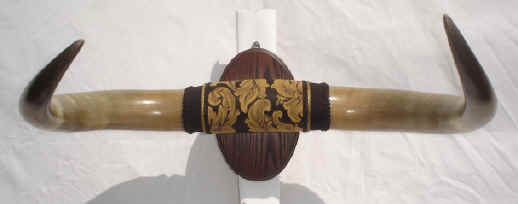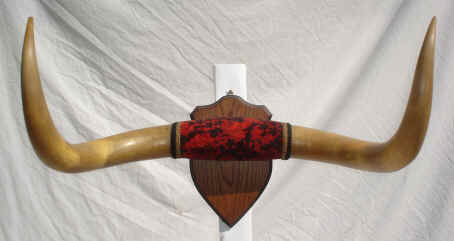|
Old Photos of Longhorn
Cattle
Steers, Bulls and Cows
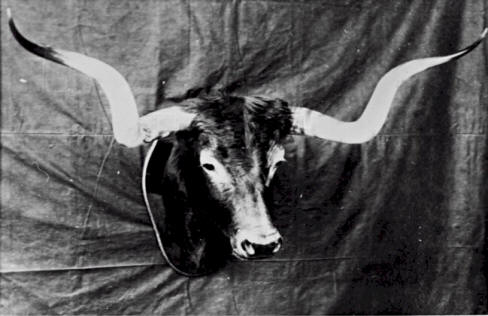 |
A
Gift to a President
Only a handful of steers would have grown horns as shapely as these, and
they are not the size and shape of horns that would have been commonly seen
on traildrives. This mounted head was given to President William McKinley in
1897 from Victoria, Texas rancher Dennis Martin O'Connor. Into the steer's
right horn was inlaid a Texas star. Into the left horn was inlaid a buckeye,
in honor of the President being from Ohio, the Buckeye State. President
McKinley was assassinated in 1901. Whereabouts of this head are unknown. |
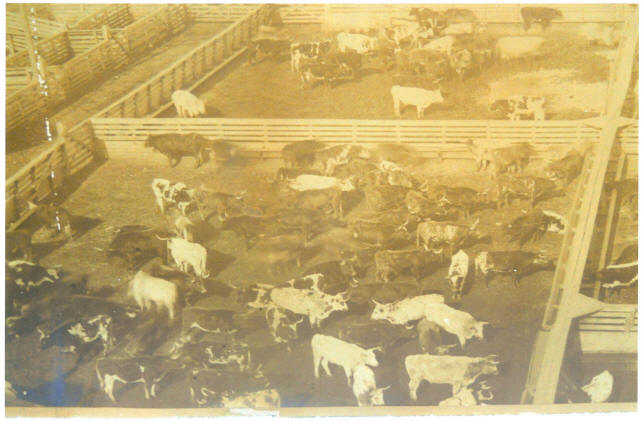
Kansas City Stockyards
.... About 1880
Hundreds of thousands of Texas cattle and the horns they grew in the 1870's
and '80's looked like this.
During this period, a set of horns 4 feet wide, tip to tip, would have been
noteworthy on steers.
In the latter 1860's and early '70's, some teen-aged steers would have been
among a trail herd, but in the minority. Typically, steers shipped to market
were probably 3 to 4 years old and hadn't lived long enough to grow horns as
big as they might have. They needed genetics, too, as age alone will not
produce trophy horns. Later on, as Longhorns were being cross bred with
other breeds of cattle, their genetics improved, which allowed for larger
body size and horn growth. |
|

Fancy horns on an old steer.
Owned by the Miller Brothers of the 101 Ranch, Ponca City, Oklahoma.
|

A TRUE OLD TEXAN
In the Ft. Worth Stockyards, 1907.
True to his breed -- rangy and lean. |

Texas Longhorns 1912
Cornered in a stockyard -- and alert.
|
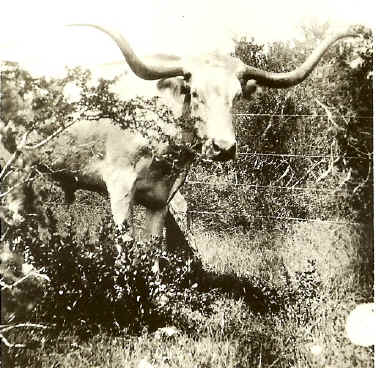
A steer once owned by Bob Hinnant of Hebronville,
Texas.
Horns 5 1/2 feet, tip to tip. 1928.
Shipped to the government herd at Cache, Oklahoma.
Of the old fashioned, true yellow color. |
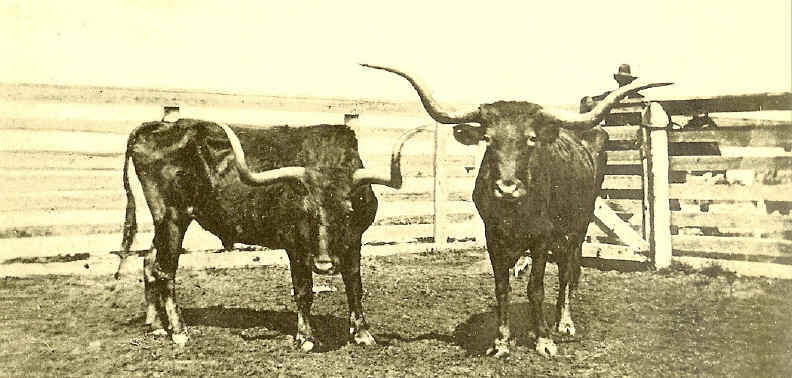
Early steers of the trophy class.
Photo by Harlan York of Austin, Texas, 1910.
The steer on the left having particularly good horns because of their twist and curl.
Both steers well above average in their day.
|

A true paint color pattern.
A pet steer on the King Ranch of Texas, 1936.
Horn tips are fitted with decorative metal knobs.
In addition to branding
cattle for identification purposes, ranchers also cut some form of notch in the animal's
ear. This steer carries a noticeable notch on his left ear.
|
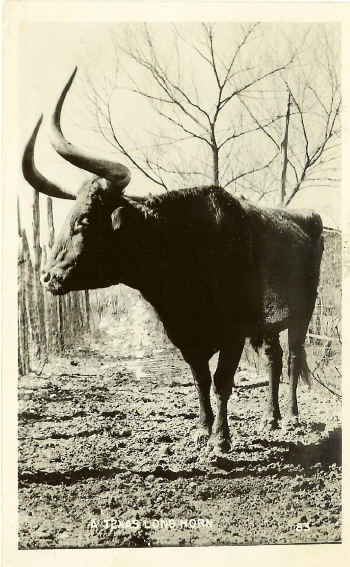
A great example of the forward and up growth pattern. |
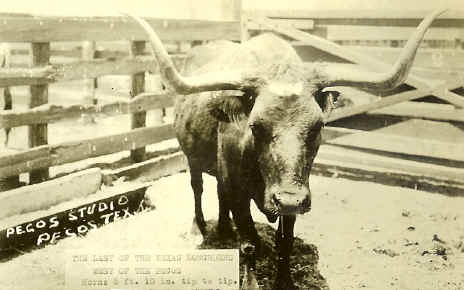
Pecos, Texas
|

An outlaw steer who avoided being roped by cowboys for many
years is seen here in the 1920s. Shapely horns -- the type that knowledgeable collectors
like to find. Notice the high ground clearance. |
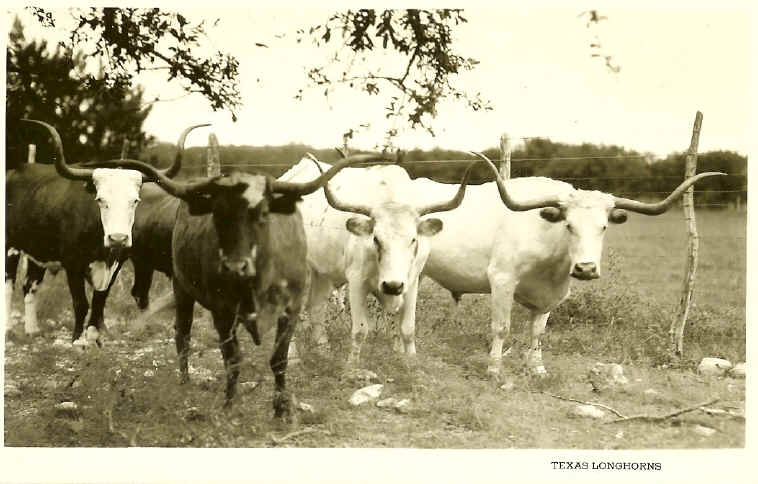
Cattle seem to have a high degree of curiosity.
Here they are wondering about the photographer who took this picture in the 1930s on the
famous YO Ranch of Texas. Steer on the left has obvious Hereford influence.
|

Taken somewhere in a large
Texas city in 1936. Just as they do today, a fancy Longhorn steer can draw a crowd!
|
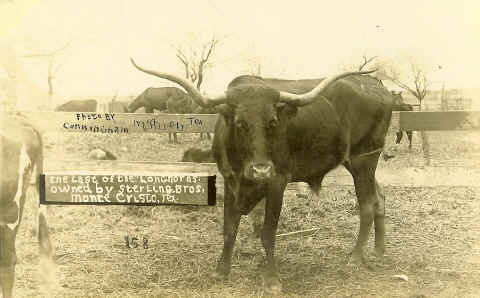
The Texas steer Big Bill,
whose horns were 5 1/2 feet wide,
tip to tip.
|
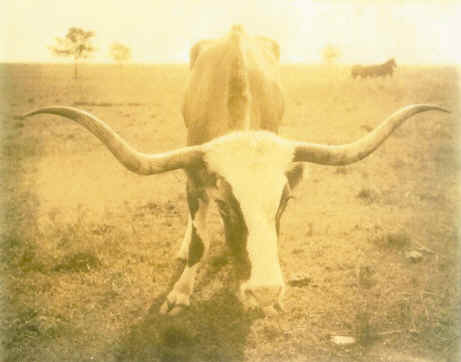
A bald-faced steer of south Texas
named Alamo, who gained much celebrity when he appeared in the 1923 motion picture
"North of 36".
|
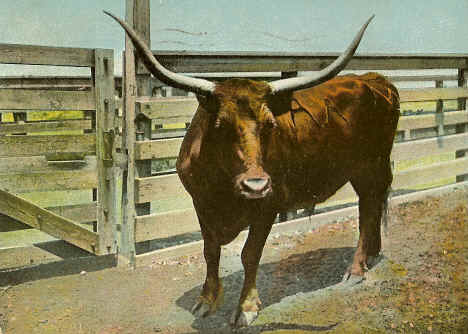
Not all Texas steers produced horns with twist and curl. This colorized photo of about
1910 shows very large brands on the rib cage, easily seen in open country. |
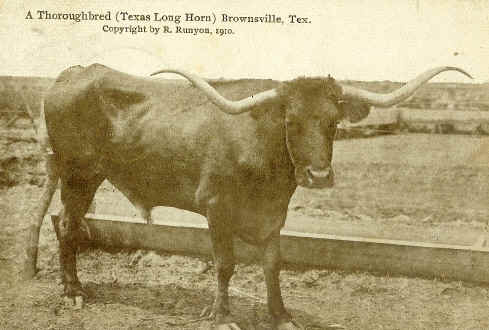
A teenaged steer having a lot of shape for such a larger
sized set of horns. His conformation is typical of his breed.
|
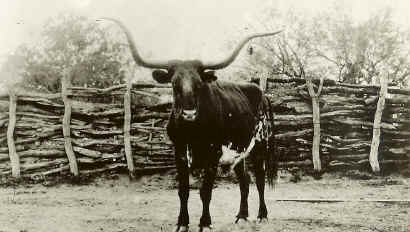
Geronimo, owned and raised by rancher George West after whom
the town George West, Texas is named. At Geronimo's death, his entire body was mounted and placed on display. After
many years and much deterioration, he was remounted and now may be seen in his glass
corral on the square at George West. |
To the right is a mounted head of the 1920s in Oklahoma. A
really fine set of steer horns! During this time, taxidermists were still using the
animal's full skull and large amounts of plaster. Some of these old mounts weighed out
heavily.
In the traildriving days, steers crossing
the Red River probably weighed between 700 and 900 pounds at three to four years of age. |
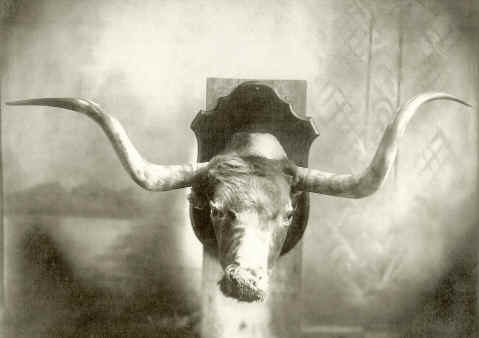
|
| |
Longhorn
or Mexican Bulls
Are of Spanish origin and are essentially the same
type as were seen in the fighting arenas of Spain. |
|

Seen above in 1935 are two bulls on the Wildlife
Refuge in southwest Oklahoma, owned by the U.S. government.
(Photo: Wichita Mountains
Wildlife Refuge, Cache, Oklahoma)
|
In the Old West, when calves were rounded up for branding, about
one in every ten bull calves was kept for breeding purposes. The others were castrated and
became steers. Large numbers of bull horns were not collected. They were shorter, stockier
and less shapely than cow and steer horns. Bull horns typically had a forward and up
growth pattern and would have not often reached 30 inches, tip to tip. Bulls have shorter
lives than cows and steers and, on the average, would live ten to thirteen years. These
early Mexican-type bulls, at maturity, might weigh around 1100 pounds. |

Some of the original Texas
Longhorn cows purchased for placement in the U.S. Government herd at Cache, Oklahoma.
1927.
|

|
Seen to the left are two 14 year old
cows from the C. C. Thomas Ranch of Dimmit County, Texas. At the Stockyards in San
Antonio, sometime in the 1920s. Typical of early Texas cattle are the solid color
patterns, many of which were blacks, browns, whites, creams and reds -- and mixtures
thereof.
The horns of early Texas cows were
smaller than Texas steers. The horns on the light-colored cow seen here are probably not
three feet wide. |
Longhorn cows are
fierce in the defense of their calves. They know they have horns, and they know where the
tips are-- and, if cornered, can use them with great efficiency.
Longhorn cows
commonly live well into their twenties.
Mature cows like
these in the Old West period would generally weigh between 600 and 800 pounds. |
|




















